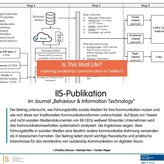Einzelansicht
Mi., 11. Nov. 2020 Busch, Jan
Mitarbeiter vom IIS-Lehrstuhl präsentieren ihre Forschung auf virtueller HICSS-Konferenz
Zwei Beiträge des IIS-Lehrstuhls wurden auf der kommenden HICSS akzeptiert und werden nun im Januar 2021 dort präsentiert. Die jährlich stattfindende "Hawaii International Conference on System Sciences" ist eine der angesehensten Konferenzen im Themengebiet "Informationssysteme und Informationstechnologien" der Welt und wird von der University of Hawaii ausgerichtet. Im folgenden seien beide Publikationen kurz vorgestellt:
Der erste Beitrag ist von Tobias Wulfert, Sarah Seufet und Christian Leyens und trägt den Titel: "Developing Multi-Sided Markets in Dynamic Electronic Commerce
Ecosystems - Towards a Taxonomy of Digital Marketplaces". In ihrem Beitrag entwickeln die Autoren eine Taxonomie für digitale Marktplätze mit besonderem Fokus auf Eigenschaften mehrseitiger Märkte und angebotener Services. Weiterhin werden Vorschläge für eine Positionierung neuer Marktplätze und Weiterentwicklung bestehender Marktplätze für Marktplatzbetreiber im dynamischen Electronic Commerce-Umfeld formuliert.
Abstract:
Multi-sided markets (MSMs) have proven to be a successful business model in the dynamic electronic commerce environment. There exists a variety of MSMs differing in their provided features and services for their participants. Existing taxonomies often focus on value creation and business-to-business transactions. We apply Nickerson et al.’s taxonomy development approach. We especially incorporated aspects of orchestrating the distinct market sides and platform governance dimensions. The developed taxonomy for MSMs consists of 21 dimensions and 99 characteristics in total. We have applied our taxonomy to 44 MSMs operating in Europe and the US. We emphasize that the taxonomy is not only an artifact for classifying the current situation of an MSM but can also be used by MSM owners to derive directions for the future development. We illustrated how these developments can be conducted by examples for five dimensions of our taxonomy.
Der zweite Beitrag wurde von Anika Nissen und Katharina Jahn im Bereich soziale Mensch-Roboter Interaktion verfasst und trägt den Titel: "Between Anthropomorphism, Trust, and the Uncanny Valley: A Dual-Processing Perspective on Perceived Trustworthiness and Its Mediating Effects on Use Intentions of Social Robots".
Abstract:
Designing social robots with the aim to increase their acceptance is crucial for the success of their implementation. However, even though increasing anthropomorphism is often seen as a promising way to achieve this goal, the uncanny valley effect proposes that anthropomorphism can be detrimental to acceptance unless robots are almost indistinguishable from humans. Against this background, we use a dual processing theory approach to investigate whether an uncanny valley of perceived trustworthiness (PT) can be observed for social robots and how this effect differs between the intuitive and deliberate reasoning system. The results of an experiment with four conditions and 227 participants provide support for the uncanny valley effect. Furthermore, mediation analyses suggested that use intention decreases through both reduced intuitive and deliberate PT for medium levels of anthropomorphism. However, for high levels of anthropomorphism (indistinguishable from real human), only intuitive PT determined use intention. Consequently, our results indicate both advantages and pitfalls of anthropomorphic design.
Konferenzlink: hicss.hawaii.edu;
Aktuelles:
 IIS-Publikation im "Journal Behaviour & Information Technology"14.10.25
IIS-Publikation im "Journal Behaviour & Information Technology"14.10.25 IIS-Publikationen auf der WI 2025 23.09.25
IIS-Publikationen auf der WI 2025 23.09.25 IIS-Publikation in der Festschrift für Prof. Dr. Zelewski: "Produktions- und Informationsmanagement"05.03.25
IIS-Publikation in der Festschrift für Prof. Dr. Zelewski: "Produktions- und Informationsmanagement"05.03.25 IIS-Talents: Erfahrungsberichte zum Event bei mindsquare09.05.23
IIS-Talents: Erfahrungsberichte zum Event bei mindsquare09.05.23- IIS-Talents: Das sind unsere Events für das Sommersemester 2023!25.04.23
 IIS-Publikationen auf der ECIS 2023 angenommen24.04.23
IIS-Publikationen auf der ECIS 2023 angenommen24.04.23 Zwei SHKs für die Unterstützung eines innovativen Lehrkonzepts gesucht! 18.04.23
Zwei SHKs für die Unterstützung eines innovativen Lehrkonzepts gesucht! 18.04.23 IIS-Publikationen auf der ECIS 2023 angenommen17.04.23
IIS-Publikationen auf der ECIS 2023 angenommen17.04.23 IIS-Talents SS 2023 - jetzt bewerben!11.04.23
IIS-Talents SS 2023 - jetzt bewerben!11.04.23 IIS-Talents: Abschlussevent beim Zeche Zollverein Essen23.03.23
IIS-Talents: Abschlussevent beim Zeche Zollverein Essen23.03.23


